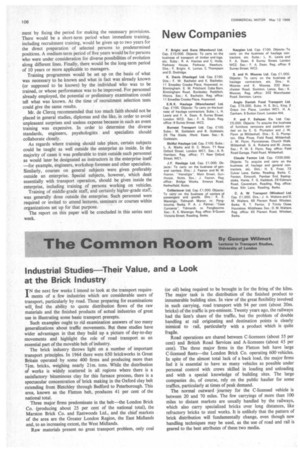The Common Room
Page 108

If you've noticed an error in this article please click here to report it so we can fix it.
By George Wilmot
Lecturer in Transport Studies, University of London
Industrial Studies—Their Value, and a Look at the Brick Industry
TN the next few weeks I intend to look at the transport require ments of a few industries which are considerable users of transport, particularly by road. Those preparing for examinations will find the ability to quote distribution flows of the raw, materials and the finished products of actual industries of great use in illustrating some basic transport precepts.
Such examples ought to rid examination answers of too many generalizations about traffic movements. But these studies have wider advantages in that they build up a picture of day-to-day movements and highlight the role of road transport as an essential part of the movable belt of industry.
The brick industry throws light on a number of important transport principles. In 1964 there were 650 brickworks in Great Britain operated by some 400 firms and producing more than 71m. bricks, weighing nearly 21m. tons. While the distribution of works is widely scattered in all regions where there is a satisfactory bituminous clay for this furnace process, there is a spectacular concentration of brick making in the Oxford clay belt extending from Bletchley through Bedford to Peterborough. This area, known as the Fletton belt, produces 41 per cent of the national total.
Three major firms predominate in the belt—the London Brick Co. (producing about 25 per cent of the national total), the Marston Brick Co. and Eastwoods Ltd., and the chief markets of the area are the Greater London Region, the East Midlands and, to an increasing extent, the West Midlands.
Raw materials present no great transport problem, only coal (or oil) being required to be brought in for the firing of the kilns. The major task is the distribution of the finished product to innumerable building sites. In view of the great flexibility involved in such carrying, road transport with 94 per cent (about 20m. bricks) of the traffic is pre-eminent. Twenty years ago, the railways had the lion's share of the traffic, but the problem of double handling at rail originating and destination points is clearly inimical to rail, particularly with a product which is quite fragile.
Road operations are shared between C-licensees (about 55 per cent) and British Road Services and A-licensees (about 45 per cent). The three major firms in the Fletton belt have large C-licensed fleets—the London Brick Co. operating 600 vehicles. In spite of the almost total lack of a back load, the major firms feel it is essential to have as many vehicles as possible under personal control with crews skilled in loading and unloading and with a special knowledge of building sites. The large companies do, of course, rely on the public haulier for some traffics, particularly at times of peak demand.
The normal outward journey for the C-licensed vehicle is between 20 and 70 miles. The few carryings of more than 100 miles to distant markets are usually handled by the railways, which also carry specialized bricks over long distances, like refractory bricks to steel works. It is unlikely that the pattern of brick distribution will fundamentally change, even though new handling techniques may be used, as the use of road and rail is geared to the best attributes of these two media.




















































































































































